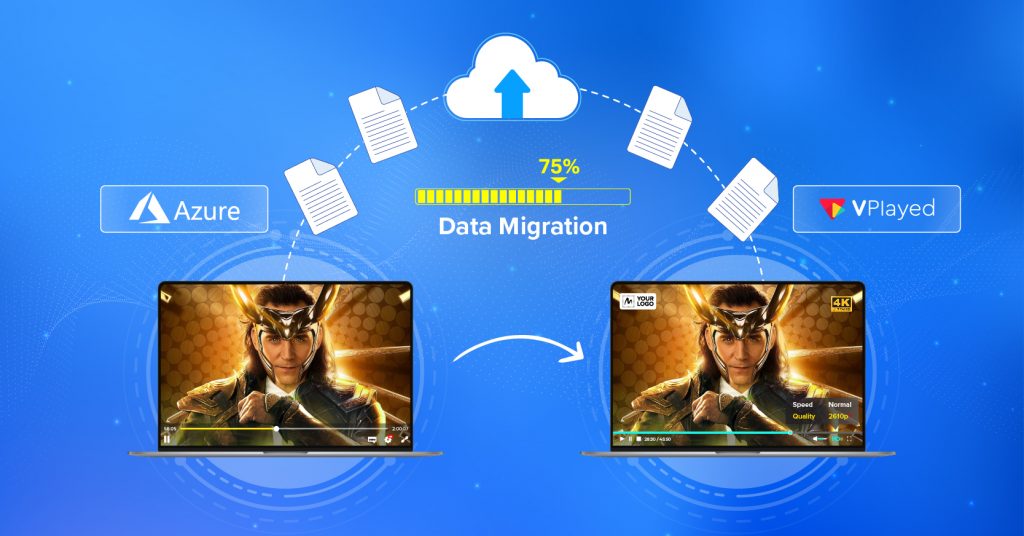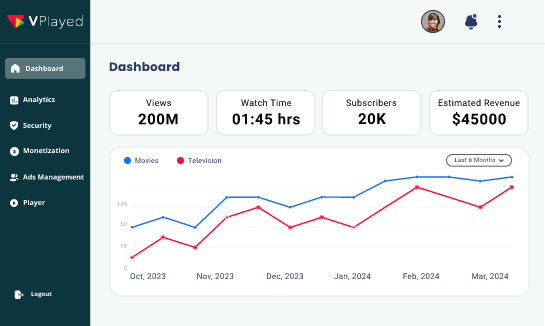Azure Media Services Retirement: Make the Switch to VPlayed

If you’re involved in the video streaming or hosting industry, chances are you’re already aware of this recent development.
Tech giant Microsoft has announced its decision to shut down its cloud-based platform Azure Media Services by June 30, 2024, signaling its apparent exit from the video workflow domain.
The closure was somewhat expected, given the departure of Azure’s CTO, Hanno Basse, last year, followed by an internal restructuring.
Over the past year, several pages on Microsoft’s website, primarily related to Azure Media Services, have been malfunctioning and left unattended.
So, how and why did AMS reach this point of no return?
To begin with, Azure Media Services never emerged as a significant player in the market. It has always been a laggard when compared to rivals such as Amazon’s Media Services.
While Amazon bolstered its media services by acquiring companies, Microsoft relied on partnerships with third parties.
A recent post on Microsoft’s LinkedIn page confirmed that Azure Media Services hasn’t been a focal point in their media strategies for some time.
As a result of this decision, thousands of streaming businesses and enterprises are now seeking viable to fill the void left by Azure Media Services.
So, let’s discuss everything about AMS and why we think VPlayed can be one of the better replacement to Azure Media Services.
Table of Contents
What is Azure Media Services?
Azure Media Services is a cloud-based platform that provides tools, services, and APIs for processing, storing, and delivering digital media content.
The platform allows users to transcribe audio and video content, encode and decode video files, and stream video content on-demand.
As one would expect, Azure Media Services supports multiple video formats like MP4 (.mp4, .m4a, .m4v)/ISMV (.isma, .ismv), Matroska/WebM (.mkv), etc.
The user can integrate AMS with other Azure services, such as Azure Container Instances and Azure Kubernetes Service, for scalable and secure media workflows.
Besides, Azure Media Services can be used to stream personalized live content, and it offers AI-powered content analysis.
When and Why is Azure Media Services Being Retired?
Azure Media Services is retiring on June 30, 2024. Microsoft’s global lead for media and entertainment, Simon Crownshaw LinkedIn post reads, “ Over the past few years, our company has undergone significant growth and transformation.
As part of this journey, we have reassessed our media strategy. After careful evaluation and consideration, we have determined Azure Media Services has not been a core component of our media strategy for quite some time.
Meanwhile, the demand for other services, such as remote collaboration, cloud rendering, and game engine-based engagement, has intensified.”
Microsoft’s official announcement stresses its focus on advancing innovative technologies and media solutions within the Azure Services platform.
This includes transitioning its distinctive features to newer products like Azure Media Player, Azure Media Analytics, and Azure Media Services for Playback.
While the reasons for retiring Azure Media Services aren’t explicitly outlined, Microsoft reassures its steadfast commitment to meeting customers’ media requirements.
The company also advises users to proactively assess and promptly transition their applications to new replacement to prevent any service disruptions.
What Services Will Be Discontinued Along With Azure Media Services?
Microsoft’s decision to retire Azure Media Services will result in the discontinuation of several associated services. Let’s discuss what these services are and how their discontinuation will likely affect the users.
| Services | Feature | How it will affect users |
|---|---|---|
| On-demand Encoding | It means converting video files into various formats suitable for online streaming. It allows users to process video content and make it compatible across different devices and internet speeds. | The loss of this service could impact users relying on on-demand video content in different formats. It could potentially affect their ability to stream content smoothly across diverse platforms. |
| Live Streaming | It will enable real-time broadcasting of events, conferences, live shows, and similar content over the internet. | Its termination means users must find replacement platforms to broadcast and share live content with their audience. |
| On-Demand Streaming | It means delivering pre-recorded video content over the internet. | Similar to the termination of live streaming, users will need to migrate to other platforms for hosting and delivering their media. |
| Content Protection Workflows | It safeguards video content through encryption and digital rights management (DRM) solutions. | The cessation of this service could pose challenges for users who depend on secure methods to protect their content. This will mean users will have to transition towards a safe and sustainable to AMS |
| Azure Media Player | It is a customizable video player that allows for seamless playback of video content across devices and browsers. | The shutdown of Azure Media Player will affect users who have integrated this player into their websites or applications for video playback. |
Consequently, these shutdowns will primarily affect businesses, content creators, and enterprises that rely on Azure Media Services for their video hosting, streaming, and protection needs.
So, what’s the bottom line?
This situation leaves them with two options — either shutting down their streaming service entirely or transitioning to other media services to sustain their operations.
What Should the Existing AMS Users Do to Continue Operations?
The existing AMS users can resort to any or all of the following options.
1. Search for a better AMS replacement
Azure Media Services (AMS) users should search for replacement media service providers offering similar features. They should compare and assess available options while taking into account factors like pricing, features, scalability, and ease of migration.
Remember, it is extremely crucial to plan the transition well in advance of the AMS shutdown (scheduled for June 30, 2023) to avoid service disruptions.
2. Retrieve the existing files.
The user must ensure the preservation and safe retrieval of their existing media files hosted on Azure Media Services. Users can download and back up all their content to prevent any further loss or downtime during the transition period.
3. Diversifying their revenue streams
Revenue diversification plays a crucial role in the sustenance of any business.
To mitigate the impact of the AMS shutdown, users should explore diversifying their revenue streams within their streaming business. Diversification helps stabilize revenue sources and reduce dependency on a single service or platform.
But how do you diversify revenue streams?
You can explore additional monetization strategies like advertising, subscription models, pay-per-view, or partnerships.
4. Data migration planning
Develop a structured plan for data migration to the new service provider. It includes organizing and transferring content, settings, and configurations systematically to avoid data loss or any corruption during the transition.
5. Communication and customer notification
Informing and updating your end-users or customers about impending changes is essential. A loyal user rightfully expects to receive consistent updates and information regarding the changes in the service they have been using for an extended period.
So, keep your users informed regarding the transition, potential service interruptions, and the steps being taken to minimize disruptions.
Why You Should Switch to VPlayed for Media Streaming Services?
VPlayed might well be the perfect AMS replacement that you may be looking for several reasons. Let’s discuss them one by one.
1. Better video transcoding
Azure Media Services was known for its stellar video encoding capabilities. But VPlayed takes it one step further with superior cloud video transcoding that lets you encode and transcode multiple video files together.
It means you can optimize your video playback for every device for a super-smooth, buffer-free viewing experience.
Recommended Reading
2. Adaptive bitrate streaming and HLS streaming protocol
Similar to AMS adaptive streaming technology, VPlayed’s ABR streaming adjusts the video playback quality based on the user’s connection speed and the device’s specifications.
3. Content protection with multi-DRM & encryption
Like AMS, VPlayed features a multi-DRM solution for better-licensed video content management. In addition, advanced security protocols like SSL certificates and AES encryption make your video streaming service virtually impregnable to piracy and unauthorized access.
4. Seamless live streaming
Streaming live videos at ultra-low latencies (as low as 10 seconds) is one of the trademark capabilities of VPlayed. In addition, VPlayed lets you record live streaming videos and stream them on-demand, any number of times in the future.
5. Global content distribution
AMS has content distribution networks that cover almost the entire world.
Similar to Azure, VPlayed’s distribution networks are vast and one of the most extensive in the world. It facilitates ultra-fast, reliable content delivery every time your viewer tunes in.
6. Migration to VPlayed is fully secure and lossless
Above everything, VPlayed assures all its clients a 100% secure and zero data loss migration.
Some of the largest enterprises and video businesses have migrated to the platform without hassles — transferring all their user and payment data, video content, and their entire setup in a matter of a few days.
How Do You Migrate From Azure Media Services to VPlayed?
At VPlayed, we ensure migration from Azure media services is a safe, straightforward, and user-friendly process.
We deploy a dedicated migration team for clients migrating from AMS to VPlayed.
The team will oversee your migration process and help you in every stage, in case you need it until all your data is fully migrated.
You can contact our team for all safe and secure AMS migration queries.
Frequently Asked Questions (FAQs)
Azure Media Services is a cloud-centric solution designed for processing and delivering media content. It is being retired to streamline Microsoft’s media services offerings, enhancing focus on newer solutions like Azure Video Indexer and Azure Video Analyzer.
The alternative platforms for Azure Media Services include VPlayed, GUDSHO, Wowza, Amazon Web Services (AWS), IBM video streaming, and several others. Each presents distinct capabilities and features. Explore the offerings of each platform to determine the one that best aligns with your business needs.
Azure Media Services’s retirement date is June 30, 2024. Ensure a smooth transition to other services before this date to avoid disruptions in your media workflow. Plan accordingly to make the shift seamlessly and maintain uninterrupted operations.
The retirement of Azure Media Services won’t immediately impact existing customers. Microsoft encourages a smooth transition to replacement services readily available in the market. They offer top-notch features, ensuring an uninterrupted media workflow and a reliable transition pathway for current Azure Media Services users.
The services of Azure are being retired, including media encoding, storage and delivery solutions, transcoding functionalities, detailed analytics, and much more. As part of the transition, users are advised to explore other services that offer comparable functionalities to address the evolving needs of media processing and delivery.

